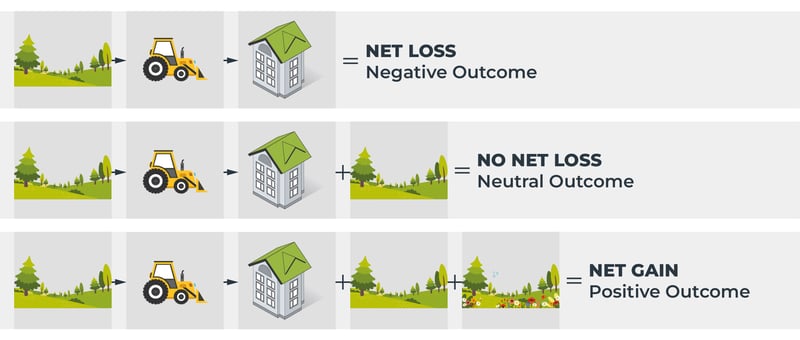The new Biodiversity Net Gain (BNG) regulations are set to come into effect in January 2024 and are part of the Environmental Act 2021 which promotes nature positive change in the UK. These regulations have been curated by the UK government to help aid the recovery of nature throughout England and they apply to developers and land managers and will be regulated by local planning authorities. The aim of these land management regulations is to ‘leave the natural environment in a measurably better state than it was beforehand’. The UK government, alongside Natural England, have created the Biodiversity Metric 4.0 and will require all developments to show a 10% Net Gain in biodiversity in their planning applications from January 2024.
Does it apply to me?
- If you are putting in planning permission for a residential development in England which has 9 or more dwellings and an area greater than a hectare or, where the number of dwellings is unknown, has an area greater than 0.5 hectares, this regulation will apply to you.
- If you are planning a non-residential development in England which has a floor space area greater than 1,000 m2 or an overall area of more than a hectare, this regulation will apply to you.
- Smaller developments, those with fewer than 9 dwellings, or less than 1,000 m2 of floor space, this regulation will not immediately affect you. However, the UK government has plans to have a regulation for such developments which will likely come into effect in April 2024.
- If you are submitting a householder application, building a small-scale self-build or custom house building this regulation does not yet apply to you.
- If you have submitted your application before the regulation comes into effect, either in January for large sites or April for small sites, this regulation will not apply, although it is strongly recommended that you still consider BNG on your site.
- If you own land which is greater than a hectare in England, you may be able to sell biodiversity units to developers who cannot reach 10% net gain on-site. More information on this topic will be coming soon.
What do I need to do?
If you are a developer, you will need to consider in your land development plans a strategy for how you will contribute to the recovery of nature in that local area.
This is quantified by the DEFRA/Natural England’s Biodiversity Metric 4.0, from which you will need to determine your baseline biodiversity and then show a 10% BNG after the development of the land is complete. This does not have to be entirely on-site and can include the purchasing of biodiversity units off-site from land managers.
Developers must "try to avoid loss of habitat to a piece of land you plan to do development work on. If you cannot do this, you must create habitat either on-site or off-site.”
What is the Biodiversity metric?
The biodiversity metric is a way of calculating the biodiversity value to wildlife of a specific area or site. It can be used to assess an area of land, demonstrate net losses or net gains in biodiversity due to changes in the land use, quantifiably measure direct impacts on biodiversity and compare different proposals for a specific site for example whether it will benefit greater from the enhancement or creation of new habitats. It will help developers to better take into account biodiversity when designing, planning and making land management changes. It is advised that this metric is used in conjunction with ecological advice. The metric currently covers land and inter-tidal habitats such as hedgerows, rivers and grasslands and is applicable to site larger than a hectare.
The small sites metric is currently under development and is an adapted version of the Biodiversity Metric 4.0 which will allow the calculation of biodiversity value for smaller sites less than 9 dwellings or less than a hectare in area.

What do I need to calculate my biodiversity value?
The Biodiversity metric requires the types of habitats, size of each habitat, the current condition of the habitats and the strategic significance of the area, which describes whether the location has been previously identified as a local nature priority.
The current biodiversity metric only applies to large sites, but a similar but adapted version has been developed for small sites which applies the same data requirements.
What if I do not reach 10% Net Gain on-site?
If you cannot either improve biodiversity on-site then you must either purchase units from a land manager or as a last resort you can purchase statutory credits from the government. This must be the last resort and you must consult an ecologist to prove this is the only option for your site. Prices for these statutory credits vary depending on the biodiversity value of your site.

Who approves my BNG plan?
When submitting your planning permission application, local planning authorities will also request to see your BNG plan as part of your application and this strategy will have to be approved by this local planning authority before you can start work on the development.
What happens next?
The UK government have announced that there will be more information released regarding the new BNG regulations by the end of November 2023, this will include the official date the regulation will come into effect.
FIND OUT HOW THE NEW REGULATIONS AFFECT YOU
Get in touch with our team of scientific biodiversity experts for a free consultation today.



